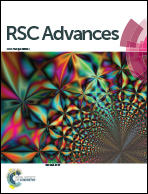Improved broadband and omnidirectional light absorption in silicon nanopillars achieved through gradient mesoporosity induced leaky waveguide modulation†
Abstract
Metal assisted chemical etching in combination with nanosphere lithography is a low cost fabrication method to produce Si nanopillars (SiNPLs) with controlled size, periodicity and high aspect ratio on a large scale. These SiNPLs show a refractive index gradient condition from top to bottom of the SiNPLs due to the presence of inhomogeneous mesoporous structures. Here, for the first time we report the omnidirectional and polarization insensitive light coupling through mesoporosity induced waveguiding in SiNPLs. The optimized sample shows a minimum reflectance of <4% over a broad range of angles of incidence 8–48°. The inhomogeneous mesoporous structures on the top of SiNPLs act like a three dimensional grating to couple the light into waveguide modes and made headway for the omnidirectional light absorption. By using angle resolved reflectance spectra and angle dependent Raman scattering, we confirmed that the inhomogeneous porosity plays a significant role in the omnidirectional light trapping, especially in the lower wavelength region, where the nanopillar absorption dominates. Finite difference time domain (FDTD) simulations have been performed to examine the omnidirectional light absorption theoretically and to find the leaky waveguide modes associated with the SiNPLs. This work focuses on the porosity induced fundamental light trapping in SiNPLs, which is highly desired in the design of photonic and optoelectronic devices.


 Please wait while we load your content...
Please wait while we load your content...